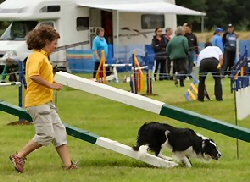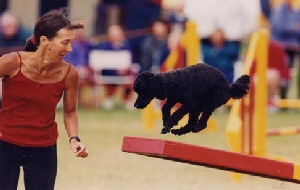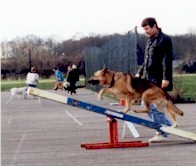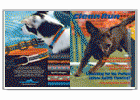| |
An evaluation of the motions of
competition seesaws
 For
a long time Monica Percival, editor of Clean Run magazine, has been interested - and
concerned - about the construction of various seesaws used in American agility and their
possible effect on their dogs. More and more it seemed like they might be sacrificing safety
and function in an effort to produce equipment that's easier for us to lift, move, and store.
So she asked I. Martin Levy, MD and Peter A. Torzilli, PhD to do a small research study to
evaluate the normal motions of the seesaw, factors that influence those motions, and to
delineate the undesirable events that occur. The resulting paper was too large to publish here
but they have allowed us to preview this summary of their findings. For
a long time Monica Percival, editor of Clean Run magazine, has been interested - and
concerned - about the construction of various seesaws used in American agility and their
possible effect on their dogs. More and more it seemed like they might be sacrificing safety
and function in an effort to produce equipment that's easier for us to lift, move, and store.
So she asked I. Martin Levy, MD and Peter A. Torzilli, PhD to do a small research study to
evaluate the normal motions of the seesaw, factors that influence those motions, and to
delineate the undesirable events that occur. The resulting paper was too large to publish here
but they have allowed us to preview this summary of their findings.
The seesaw is unlike
any other obstacle on a dog agility course because the performance on the obstacle
depends on the performance of the obstacle. Variations in plank, fulcrum, and base
construction directly influence the motion characteristics of each seesaw design. In an effort
to insure consistency of performance, the various organisations for dog agility have been quite
specific about plank dimensions and pivot height. Still, they have been less precise when
defining a seesaw’s response to varying conditions of load. Because of this, various seesaw
solutions have been designed and constructed, each with its own set of performance
characteristics. The rate of descent, support-base movement, plank vibration, and noise are all
influenced by the design solution and the materials chosen to execute that design.
 The
effect of design on performance The
effect of design on performance
In an effort to
understand the effect of design variations on seesaw performance, we evaluated three distinct
designs. The purpose was to determine how each design reacted to an applied load. In addition,
we wanted to understand how varying the load and the point of load application affected the
response of the seesaw. Finally, we wanted to determine how each seesaw responded to the abrupt
cessation of plank rotation.
Materials and Methods
Max 200 (Port Byron,
New York), Action K-9 Sports Equipment (Sun City, California), and Premier Agility Equipment
(Surrey, England) seesaws, all of which are used regularly in competition, were evaluated. They
were selected because each had distinct design elements.
We performed three
sets of tests. In the first test, we placed sandbags of known weights (5, 10, 20, 30, and 50
pounds) on the descending arm of the seesaw, at known distances from the end of that arm.
Initially, we held the descending arm, with a sandbag in place, in the starting position. We
then released it and measured the time from starting position to impact with the floor to the
hundredth of a second. We performed a second set of tests to determine the stiffness of the
boards. In the third set of tests, we evaluated the amount of ascending-arm-induced bending
('board whip') by tracing the travel of that arm during normal seesaw motion.
 We
plotted the results of the drop tests for a known load for each seesaw as 'distance from tip'
versus 'time.' We compared the drop tests at 5 and 30 pounds for the three seesaws and
illustrated them on a single plot shown in the graph. We determined the stiffness of each
board: The Premier board had the greatest stiffness and the Action K-9 board the least. The Max
200 board was only slightly stiffer than the Action K-9 board. We
plotted the results of the drop tests for a known load for each seesaw as 'distance from tip'
versus 'time.' We compared the drop tests at 5 and 30 pounds for the three seesaws and
illustrated them on a single plot shown in the graph. We determined the stiffness of each
board: The Premier board had the greatest stiffness and the Action K-9 board the least. The Max
200 board was only slightly stiffer than the Action K-9 board.
The 'board whip'
measured at 30 pounds for all three boards. The averaged K-9 board-whip value was 14 cm., the
averaged Max 200 board-whip value was 10.4cm and for the Premier board, 9.3 cm.
Discussion
Fulcrum design
influences the speed at which the board descends. For two designs it is evident that smaller
loads take longer to fully displace the descending arm. For the fulcrums with square on round
tube or round on round tube assemblies (Action K-9 and Max 200, respectively), as the leverage
decreases (the distance of the load from the end increases), the descending arm slows even
more. When we applied light loads at increasing distances from the end, the descent of the
board slowed considerably. In contrast, the low-resistance blade/plate fulcrum (Premier) had
less effect on the rate of descent of the board for both light and heavy loads, applied at
varying distances from the board end.
 Board whip
appeared to be a function of the stiffness of the board. In this study, the more flexible
boards (Action K-9, Max 200) were associated with greater amounts of board whip, resulting in
catapulting of their loads—the sandbag bounced off the end of the board. All three
boards still had to dissipate the energy developed in the ascending arm. This energy was
transferred to the base, which resulted in two of the seesaws 'hopping.' In the case of the
Premier seesaw, however, the linkage in the base dissipated the upward force, and whipping,
catapulting, and hopping were minimal. Board whip
appeared to be a function of the stiffness of the board. In this study, the more flexible
boards (Action K-9, Max 200) were associated with greater amounts of board whip, resulting in
catapulting of their loads—the sandbag bounced off the end of the board. All three
boards still had to dissipate the energy developed in the ascending arm. This energy was
transferred to the base, which resulted in two of the seesaws 'hopping.' In the case of the
Premier seesaw, however, the linkage in the base dissipated the upward force, and whipping,
catapulting, and hopping were minimal.
Recommendations
-
It is important
that agility’s governing organizations establish a more precise set of specifications for the
seesaw to include the stiffness of the board and the response of the obstacle to a variety of
load conditions. These parameters will allow a dog to anticipate a predictable performance
from the obstacle. A single maximum time limit for a single load does not adequately
characterize the performance of a seesaw obstacle.
-
To insure that a seesaw obstacle’s
performance is similar for both small and large dogs, we recommend using blade/plate
fulcrums. Their use will avoid the frictional effects of the tube-on-tube assemblies and the
variations in response to different loads that are a by-product.
-
Although stiffer boards exhibit less
board whip (and catapulting), launching or hopping of the base remains a problem.
Incorporating force attenuators into the base can eliminate launching.
About the
authors...
I. Martin Levy, M.D. and Peter A. Torzilli, Ph.D. founded The Center
for the Scientific Advancement of the Sport of Canine Agility in Ardsley, New York. Monica
Percival is editor of Clean Run.
 Note:
The information included in this article is a brief summary of their findings. For a free copy
of the complete research report, please go to
www.cleanrun.com/surveys.cfm. Note:
The information included in this article is a brief summary of their findings. For a free copy
of the complete research report, please go to
www.cleanrun.com/surveys.cfm.
Or you can read the full article in the
August issue of
Clean Run magazine.
| |
|